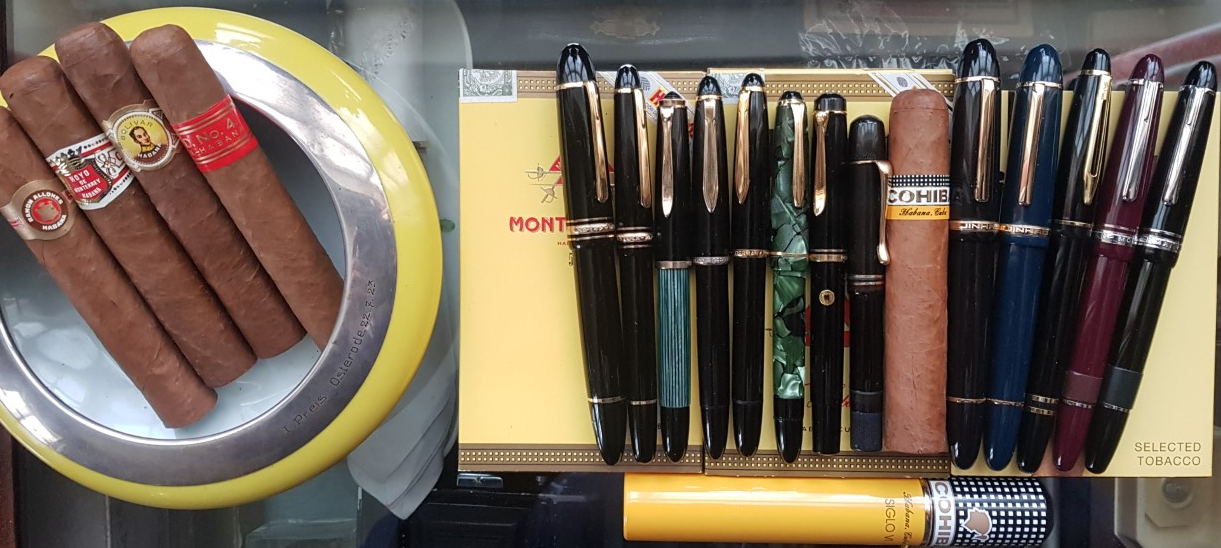The Star Rating values in the first edition should be used only as a guide. COHIBA cigar is not a fountain pen. You can consider many more rules, but we have selected the fundamental eight rules for users, collectors and those researching fountain pens which, hopefully some might find useful:
- Easy to Grip, as expressed in context of level of comfort when combined with ergonomic design, which provides required comfort and efficiency. Good example here is the uncompromising design of LAMY fountain pen, in model called Safari Vista. Easy to Grip is also an important answer for those with unfortunate chronic pain such as arthritis or sensitivity in their hands, wrists, or fingers.
- Everyday Use (and carry), is the practical aspect of any serious and frequent use of writing instruments, also taking care specifically over pen(s) you intend to use and carry with you each and every day.
- Comfortable to Hold, we believe that the overall shape of a pen posted or not, is probably the single biggest factor in accepting whether the pen is comfortable for you or often is not. This is very subjective area, with other major factors including the length of the nib and the pens with its full ink weight added and overall balance. Finally, the grip section which, if it is too small/wide or too short/tapered, you’ll immediately feel it. The uncomfortable grip section, will affect how you feel about, even with the most beautiful pen. Last but not least, depending on the size of your hands, the comfortable to hold impression to some, might be just the opposite to others.
- Smooth Writing, is the essence of a potential problem. The complexity and types of nibs available makes the feeling of writing with a fountain pen both smoother and richer. What makes most fountain pens so unique is that they can be purchased and fitted with a large number of various nib types, sizes and made in different materials.
- Writing Control, some pens are much easier to control then others. Fountain pens should be kept at a 40–50-degree angle on your desk or your writing surface. Apparently, ink tends to flow much easier at these angles. Use much less pressure, as too much can actually damage the valuable nib, and prevent ink from flowing properly. With your fountain pen, you need to control the pen with your hand by holding the pen as naturally as possible and keep your fingers and wrist rigid, whilst simultaneously moving both your arm and shoulder to move the pen as required.
- Range of Nib Sizes available, a typical nib decision starts with the question of what purpose you would like to use your fountain pen for. Is it for daily writing, signatures or even drawings. Have you used fountain pens before? Your handwriting should be analysed and ideally corrected regarding several aspects linked to the correct usage of a nib, type of writing paper, pressure used, writing style and direction and the size of the format of your letters. The three geometrics and different nib widths are as follows: EF (extra fine), F (fine) and M (medium). The M and F nib sizes are most popular. The B (broad) and BB (extra or double broad) are used generally by more experienced users, but certainly not always.
- Post Sales Adjustments offered, relating to usual ranges of contemporary produced fountain pens, where the original purchased nib size and type can be altered, replaced or even a custom nib be designed and produced. In the case of historic writing instruments this option is not often available, however aftermarket specialists exist and some of them are offering a very comprehensive writing solutions.

8. Value for Money, this is a very complex subject. The provenance of the brand itself, quality and sophistication of design, expensive materials, quality of workmanship, quality of the final product control and the practical value of customer warranty as well as the level of customer service, critical here. Just comparing the features of individual pens is not enough. This area can be very subjective too. There are other costs too including VAT, shipping costs and import duties (e.g., post Brexit and from other parts of the world).
Classic fountain pens can often be very valuable, especially if they are in good or very good condition. A typical and common popular value of even some interesting vintage fountain pens can be found between £50 – £150. Naturally not all old fountain pens are rare or considered classics. Many vintage pens are offered with original nibs, and often with 14/18/21 K solid gold nibs, which increase their market value. Pens in poor condition or offered as parts or for restoration will be worth no more than 50-75% of the good ones, however, the rare nib element in can sometimes be worth more than the pen itself.

